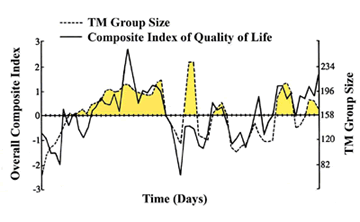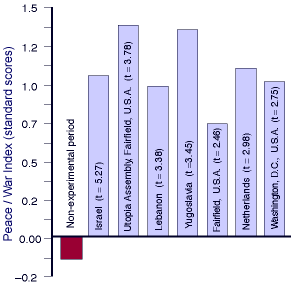Effect on War
The power of peace-creating meditation groups to decrease war has been analyzed in many studies. The results produced by groups that have gathered temporarily (for weeks or months) have been consistently positive—with nearly immediate reductions in war deaths averaging better than 70%. For results of a long-continuing group, see below. A few examples:
|
| Reduction of warfare in Lebanon—plus improvements in crime, fires, accidents and the stock market |
|
 |
|
A day-by-day study of a two-month assembly in Israel during August and September of 1983 showed that, on days when the number of participants at a peace-creating assembly (“TM Group Size,”) was high, the intensity of an ongoing war in neighboring Lebanon decreased sharply. When the number of participants was high, war deaths in Lebanon dropped by 76%. (p<.0001). [The mathematical expression p<.0001 indicates that, as a result of standard mathematical analysis, the likelihood that this result could be attributed to chance variation in levels of fighting was less than 1 in 10,000. This amounts to a much higher confidence level than is typical in the social sciences.]
The same study also demonstrated improvements in a wide variety of social indicators—including crime, traffic accidents, fires and the stock market. These various measures ordinarily have no correlation (you can’t predict the stock market by watching crime statistics, for example). The fact that they all improved together—in correlation with increases in meditation attendance—strongly indicates that peace-creating assemblies radiate a generalized influence of harmony and coherence throughout society that can be measured many different ways.
The figure above illustrates a highly statistically significant correlation between daily changes in attendance at this peace-creating assembly and the daily changes in a composite quality-of-life index that measured all the variables together—war, crime, fires, accidents and the stock market. The correlation is so strong it can be seen in the raw plot of the data—even without mathematical analysis.
This study was accepted for publication in the most highly regarded journal of peace studies (Journal of Conflict Resolution 32: 776-812, 1988).
|
| Reduced Warfare in Lebanon |
|
 |
|
This study is a replication of the war-reducing results in Lebanon found in the previous study. This time the researchers looked at not just one peace-creating assembly, but seven consecutive assemblies (93 days altogether) over a two-year period during the peak of the nearly continuous Lebanon war. Some of these assemblies were relatively small but close by (one in Lebanon itself, and one in neighboring Israel). Some of these assemblies were large (6,000-8,000) and distant (Holland and the United States). By a ratio of size to distance, all of these assemblies were large enough, in theory, to affect the fighting. This study is especially significant because the ongoing warfare in Lebanon was a combination of conventional warfare, guerilla warfare, and terrorism. As compared to all the other days in the 841-day study, during the 93 days of those peace-creating assemblies:
- war-related fatalities decreased by 71% (p < 10-10)
- war-related injuries fell by 68% (p < 10-6)
- the level of battles and other conflict dropped by 48% (p < 10-8)
- cooperation among antagonists increased by 66% (p < 10-6).
These four results were combined into a composite Peace/War Index for the Lebanon War between June 1983 and August 1985 (see chart above). During each of the seven experimental periods, time series impact assessment analysis indicates significant progress towards peace. Because the number of days in the study was so large, and a dramatic reduction of war was replicated seven consecutive times, the likelihood that the combined results were due to chance is very nearly nonexistent—less than one part in 10-19 (p<.00000000000000000001), making the peace-creating effect of group meditations the most rigorously established phenomenon in the history of the social sciences (Journal of Social Behavior and Personality 17(1): 285–338, 2005).
|
To move to the next Summary,
click here:

To continue with more detail on this topic,
click here:

|
|


